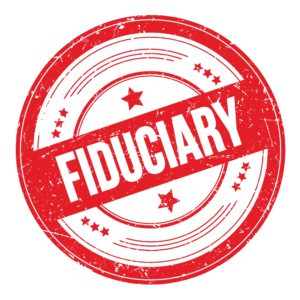
In our last post, we reviewed what a fiduciary is, fiduciary duties and the impacts of being a fiduciary. With this post, we will review best practices for individuals and businesses acting in a fiduciary capacity with respect to their company sponsored retirement plan.
Here are our recommended best practices for those working on or sponsoring retirement plans:
- Establish a committee to make decisions about the plan. It is recommended that the committee have an odd number of members and be diverse. Consider members from your human resources department, finance department, owners of the business or board of directors’ members, and perhaps legal if you have in house counsel. The committee should be responsible for both administrative oversight and investment oversight. Larger firms may consider having two committees – one for each.
- Establish an investment policy statement (IPS) which governs both what kinds of funds you put in the plan and the process by which you monitor them. Fiduciaries are not judged by how well the funds perform. They are judged by the selection process and the monitoring of the funds thereafter. For a participant directed plan, it is recommended that the IPS designates a qualified default investment alternative (QDIA) for any participant who does not make an affirmative election on their own. Be careful that what you put in writing, you must also adhere to.
- Know who you are paying for your plan and how much you are paying them. There is no aspect of your plan that is free; someone is getting paid for that service in some way. The fees being paid must be disclosed to you. Periodically benchmark your fees against other plans of similar size and demographic. Cheaper is not always better but make sure that if you are paying a higher price, there is a service add that is beneficial to the participants.
- Document everything you do – the Plan Document and required amendments, required testing, required filings, payroll processing, timing of payroll contributions, meeting minutes from committee meetings, required audits, voluntary audits, mistakes or breaches and the corrections made, fee reviews, provider reviews, participant notices.
- The Department of Labor takes issue with employers who hold participant contributions withheld from their paychecks in their business accounts. Make sure that your payroll contributions are submitted and deposited in a timely manner! As stated above, have a written documented procedure for payroll processing along with a backup for your payroll person lined up. Review the contributions when they are posted to your provider and compare both your company bank statement and the plan’s custodial trust statement to what was posted on your vendor’s website. If you find you were late in submitting, document what went wrong and seek out correction methods to remedy the failure.
- If you find you made a mistake, or one of your vendors discovers an error, fix the error through recommended correction methods and document that fix. Seek out the help of your paid vendors and hire an ERISA attorney if necessary. Competent third party administrators, recordkeepers and attorneys can guide you through the Employee Plans Compliance Resolution System (EPCRS) self-correction programs and audit programs as needed.
- Stay in touch with your participants through enrollment guides, emails, notices, posts, education sessions, one on one financial sessions with financial advisors, and newsletters. Ask participants what questions they have, what they would like to learn about or what confuses them about retirement plans to see what else you might need to offer.
- Keep your data safe! Require multifactor authentication on your network and your vendor networks. Never disclose social security numbers, dates or account numbers in an email unless it is encrypted. Use a portal system or your vendors’ portal systems. Review what your service providers and vendors do as well.
- Lastly, make sure to identify all of your fiduciaries including both those working for your firm and those vendors to whom you have delegated some of the responsibilities to. Identify anyone who is working on your plan or has delegated responsibilities who is NOT a fiduciary as well. Make sure anyone who you believe is a fiduciary has acknowledged that status in writing. If you do not feel you are an expert in an area of administering the plan or selecting or monitoring the funds, look at hiring an expert who is willing to be a fiduciary to the plan to assist you. Some examples of fiduciaries that you can hire include 3(21) investment advisors and 3(38) investment managers, and 3(16) administrators.
At ML&R Wealth Management, our retirement and investment advisory staff have many, many years of experience working with record keepers and custodians. We are happy to serve as a TPA, a 3(16), a 3(21), or a 3(38) advisor for your corporate retirement plans in Austin and ensure the longevity of your personal wealth management goals.



